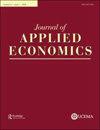Technical efficiency of U.S. Western Great Plains wheat farms using stochastic frontier analysis
IF 1.4
4区 经济学
Q3 ECONOMICS
引用次数: 0
Abstract
ABSTRACT Technical efficiency (TE) is an important measure of farm performance. This study measured the TE of wheat farms across six states in the U.S. Western Great Plains based on production and farm management-specific variables. Significant factors positively influencing efficiency were insecticide use, farm size, and tillage. Alternatively, government payments, crop insurance, off-farm income, and crop share rates had negative effects on efficiency. Kansas and Oklahoma farms were more efficient than Nebraska and Wyoming farms in the sample. Average TE score of 0.56 indicates a substantial gap between average producers and the most efficient ones located near the TE frontier. Benchmarking the highly efficient farms provides best-management practices enabling less-efficient farms move closer to the efficient frontier. Extension specialists and collaboration among farms could transfer the skills and techniques through workshops, webinars, fact sheets, and social media pages.美国西部大平原小麦农场技术效率的随机前沿分析
本文章由计算机程序翻译,如有差异,请以英文原文为准。
求助全文
约1分钟内获得全文
求助全文
来源期刊

Journal of Applied Economics
ECONOMICS-
CiteScore
3.00
自引率
0.00%
发文量
57
审稿时长
40 weeks
期刊介绍:
The Journal of Applied Economics publishes papers which make a significant and original contribution to applied issues in micro and macroeconomics. The primary criteria for selecting papers are quality and importance for the field. Papers based on a meaningful and well-motivated research problem that make a concrete contribution to empirical economics or applied theory, in any of its fields, are especially encouraged. The wide variety of topics that are covered in the Journal of Applied Economics include: -Industrial Organization -International Economics -Labour Economics -Finance -Money and Banking -Growth -Public Finance -Political Economy -Law and Economics -Environmental Economics
 求助内容:
求助内容: 应助结果提醒方式:
应助结果提醒方式:


